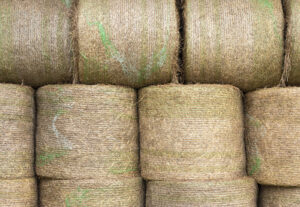 By Katie Nichols
By Katie Nichols
AUBURN UNIVERSITY, Ala.—Prices of agricultural inputs—including chemicals, fertilizers and fuel—have continued to climb throughout 2022. Unfortunately for hay producers, as well as consumers, this will likely lead to an increase in hay prices during the summer.
Ken Kelley, an Alabama Cooperative Extension System regional agent, said the market shift will have an effect on both consumers and producers.
“Producers will have to set prices that allow them to cover both fixed and variable costs in order to make a profit,” Kelley said. “On the other hand, consumers will need to be diligent when choosing how to best spend their money.”
Hay Uses
There are many uses for hay. Most consumers also know there are many different prices associated with hay sales. Round and square bales alike are options for decoration or animal bedding, as well as for mulch. Most commonly, though, hay bales are used for supplemental livestock feed through the dry summertime—when grass is not as readily available—and through the winter when there are limited forages.
Hay is a desirable food source for cattle, horses and small ruminants such as sheep and goats. Price ranges for hay sales often depend on the variety baled, the size and structure of bales and the quality of the bale.
Hay Pricing
There are many additional factors to consider when pricing round bales of hay. Alabama Extension agents and specialists have been analyzing numbers and market trends to help producers make informed decisions about pricing.
Cost of production can be broken down into two segments: variable costs and fixed costs. Variable costs are the costs that change as production changes, such as fertilizer. Variable costs only occur when farmers produce.
Kelley said one thing to note is the amount of nutrients that are removed from the soil when animals are grazing versus when pastureland is used for hay production.
“Certainly fertilizer is a huge component of profits and pricing, specifically nitrogen and potassium,” he said. “It is very costly to replace the nutrients that hay production removes from the soil.”
He said energy is another point to consider.
“Energy prices are on everyone’s mind as we consider what it costs us to fill up our vehicles, but energy prices also have a direct effect on crop input prices,” he said. “Natural gas is a huge part of the nitrogen production process, so the price of natural gas also affects the price of nitrogen even beyond the increased cost of shipping that all commodities are facing. ”
Other factors for producers to consider include the following:
- Labor costs
- Equipment depreciation costs
- Equipment maintenance costs
- Living family wage (in cases where hay production is the family’s sole source of income)
- Profit margin
Kelley said producers should consider all factors when calculating margins.
“Failure to budget and price for coverage of fixed costs will ultimately cost producers the ability to grow wealth in their operation,” he said.
Consumer Considerations
While these issues are difficult for producers to wade through, there is also the flip side. What do consumers do about rising prices?
“No one likes to see prices raised, especially when everything from groceries to gas is high,” Kelley said. “However, it is important to understand why prices are rising. It is also important to be good stewards of the money that you have available to feed your animals.”
Kelley said consumers should ask questions before making a purchase.
“Consumers can ask to see a hay sample analysis that would help them understand nutrient levels and forage makeup of the bale of hay they are considering for purchase,” he said. “Look for high-quality hay that will provide your animals the supplemental nutrition they need.”
Other considerations include bale weight or size, bale age and composition of bales.
More Information
The issues surrounding changing markets and livestock industry sustainability through a difficult season with high prices are here to stay—at least for the time being.
Kelley encourages producers to price bales thoughtfully, by including total costs in the bale price. He also encourages consumers to weigh what they’re getting for their hard-earned dollar.
Much more detailed information about hay prices is available in Pricing Hay for Profit located on the Alabama Extension website, www.aces.edu. The website also has more information on supplemental livestock feedstuffs and hay.

















